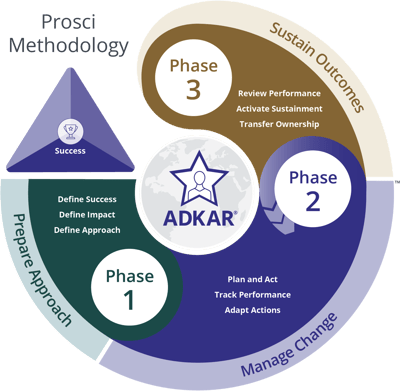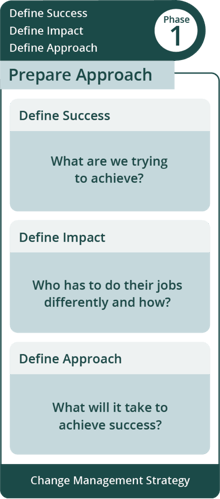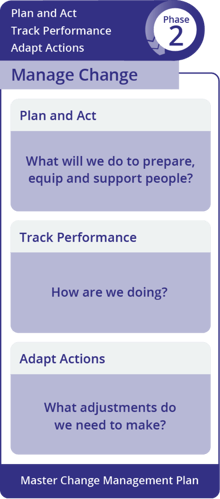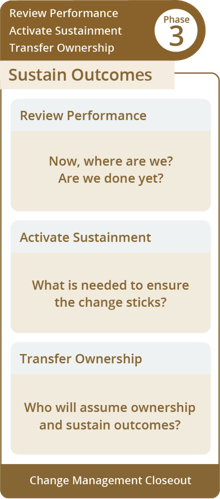Select Your Country
Selecting a different country will redirect you to that homepage.
United Kingdom
A structured yet flexible approach to enable the people side of change in your organisation.
The Prosci 3-Phase Process is one of the three main components of the Prosci Methodology, in addition to the PCT Model and the ADKAR Model. While the ADKAR Model enables successful change at the individual level, the Prosci 3-Phase Process provides a framework for achieving change at the organisational level.
Through this organisational change management process, change practitioners work through three phases (Phase 1– Prepare Approach, Phase 2 – Manage Change, Phase 3 – Sustain Outcomes) to achieve successful project outcomes.
Each phase is broken down into three stages, and each stage includes important activities to support the success of a change initiative. Although the Prosci 3-Phase Process is structured, it is also adaptable and scalable to fit the needs of any organisation or change initiative.

The first phase of the Prosci 3-Phase Process supports change and project teams in developing their change management strategy, and with the end in mind. The activities in this phase help practitioners develop a customised and comprehensive approach that positions their change for success. The three stages in Phase 1 – Prepare Approach include:

The deliverable for this phase is the Change Management Strategy, which establishes the approach needed to deliver desired project outcomes.


The second phase of the Prosci 3-Phase Process brings the Change Management Strategy to life. The activities in this phase involve developing plans and actions that help move individuals and the organisation through ADKAR transitions. The three stages in Phase 2 – Manage Change include:
The deliverable for this phase is the Master Change Management Plan, which consolidates individual plans and serves as the guiding document for the change management team.

The third and final phase of the Prosci 3-Phase Process establishes the approach for ensuring that the change is adopted and the organisation is committed to doing what’s needed to sustain the change. Related activities involve reassessing performance, activating sustainment strategies, and transitioning responsibilities. The three stages in Phase 3 – Sustain Outcomes include:

The deliverable for this phase is the Change Management Closeout, which documents the change performance status, plus prepares the organisation to own and sustain change outcomes.


The data is clear: even when organisational changes meet technical requirements and milestones, they can still fail to deliver results and benefits. What’s missing? Change management. Organisations that embrace change management are more likely to achieve project objectives, stay on or ahead of schedule, and stay on or under budget.
Stay up-to-date on our latest blogs, upcoming webinars and cutting-edge research.
You may unsubscribe from our emails at any time. See our privacy policy for more information.
